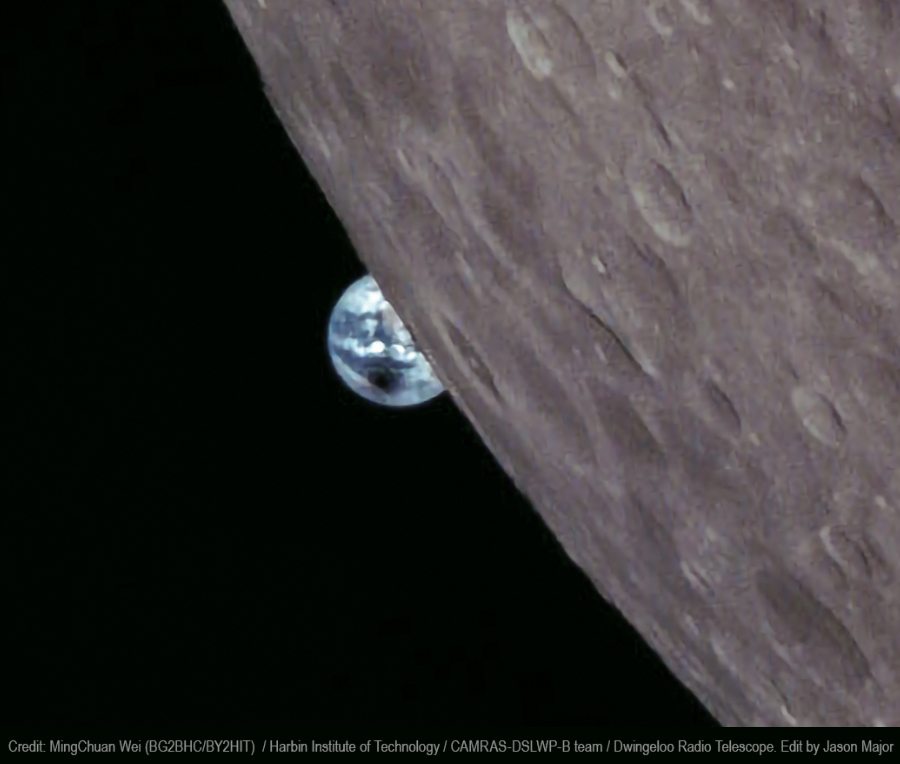|
|
Post by jandl100 on Jun 28, 2020 12:01:38 GMT
This is, imo, nothing short of amazing. "Haunting Photos Show How Last Year's Lunar Eclipse Looked From The Moon On 2 July 2019, the Moon cast its shadow on the surface of the Earth. This time, the shadow's path travelled across the South Pacific Ocean. It also passed over some of Argentina and Chile. For surface dwellers in the path, the Moon briefly blocked the Sun, turning night into day. But for one "eye" in orbit around the Moon, the view was different. A camera on a tiny satellite watched as the circular shadow of the Moon moved over the Earth's surface. The satellite is the Chinese Longjiang-2. It's a tiny microsatellite launched in 2018 as part of the Chang'e 4 mission."  www.sciencealert.com/this-is-what-last-year-s-total-solar-eclipse-looked-like-from-the-moon www.sciencealert.com/this-is-what-last-year-s-total-solar-eclipse-looked-like-from-the-moon |
|
|
|
Post by MartinT on Jun 28, 2020 12:50:01 GMT
Marvellous!
|
|
|
|
Post by MartinT on Jun 30, 2020 12:49:43 GMT
|
|
|
|
Post by user211 on Jun 30, 2020 13:24:30 GMT
All I can say is stop messing around NASA and get that James Webb up there and stop using US tax revenue as a cash cow.
I am of the opinion it has cost far more and taken way longer than a private funded equivalent would have done.
|
|
|
|
Post by MartinT on Jun 30, 2020 13:46:45 GMT
|
|
|
|
Post by jandl100 on Jul 1, 2020 10:15:01 GMT
|
|
|
|
Post by jandl100 on Jul 3, 2020 9:35:15 GMT
Video: Flight over the ice-filled Korolev Crater on Mars - simulated using actual imagery. Very impressive! This movie was created using an image mosaic made from single orbit observations from the High Resolution Stereo Camera (HRSC) on the Mars Express space probe orbiting Mars. The mosaic image was then combined with topography information from the stereo channels of HRSC to generate a three-dimensional landscape, which was then recorded from different perspectives, as with a movie camera, to render the flight shown in the video. Worth a look via this link!  phys.org/news/2020-07-video-flight-korolev-crater-mars.html?utm_source=nwletter&utm_medium=email&utm_campaign=daily-nwletter phys.org/news/2020-07-video-flight-korolev-crater-mars.html?utm_source=nwletter&utm_medium=email&utm_campaign=daily-nwletter |
|
|
|
Post by MartinT on Jul 3, 2020 9:48:19 GMT
Impressive, even to the wavy snow patterns.
Ice, I guess, not snow.
|
|
|
|
Post by jandl100 on Jul 8, 2020 14:24:48 GMT
|
|
|
|
Post by jandl100 on Jul 14, 2020 12:38:47 GMT
"A(nother) Giant 'Wall' of Galaxies Has Been Found Stretching Across The Universe ... a structure has just been discovered arcing across the southern edge of the sky, and it's a colossus, spanning an immense 1.37 billion light-years from end to end. Its discoverers have named it the South Pole Wall. Although the size is remarkable - it's one of the largest structures in space we've ever seen - we know exactly what the South Pole Wall is. It's a galaxy filament, a huge formation of galaxies that forms a border between the empty spaces of cosmic voids that together form the cosmic web." Try and get your monkey-brains around that.  www.sciencealert.com/a-giant-wall-of-galaxies-has-been-found-stretching-across-the-universe www.sciencealert.com/a-giant-wall-of-galaxies-has-been-found-stretching-across-the-universe |
|
|
|
Post by MartinT on Jul 14, 2020 14:22:58 GMT
spanning an immense 1.37 billion light-years from end to end . . Try and get your monkey-brains around that.  Nope. Failed miserably. How can a thing be that large? |
|
|
|
Post by jandl100 on Jul 15, 2020 5:37:41 GMT
A helicopter is going to the planet Mars. It 'is intended to demonstrate technologies needed for flying in the Martian atmosphere. If successful, these technologies could enable other advanced robotic flying vehicles that might be included in future robotic and human missions to Mars. They could offer a unique viewpoint not provided by current orbiters high overhead or by rovers and landers on the ground, provide high-definition images and reconnaissance for robots or humans, and enable access to terrain that is difficult for rovers to reach.' www.jpl.nasa.gov/news/news.php?feature=7703&utm_source=iContact&utm_medium=email&utm_campaign=nasajpl&utm_content=daily-20200714-4 |
|
|
|
Post by Firebottle on Jul 15, 2020 6:40:49 GMT
How much atmosphere is there on Mars?
I notice the rotors are large for the apparent weight underneath.
|
|
|
|
Post by MartinT on Jul 15, 2020 7:33:48 GMT
I was thinking the same thing. To get lift from that thin atmosphere is going to need some radical rotor design.
|
|
|
|
Post by jandl100 on Jul 15, 2020 7:43:32 GMT
Martian air density is about 1% of Earth's.
But gravity is about one third.
|
|
|
|
Post by jandl100 on Jul 15, 2020 8:36:42 GMT
|
|
|
|
Post by MartinT on Jul 15, 2020 12:02:14 GMT
Please, please, let the launch go well.
|
|
|
|
Post by jandl100 on Jul 15, 2020 13:01:54 GMT
... and the deployment of the 48 mirrors etc. It's all folded up for launch like scrunched up origami - it has to unfold like a crysanthemum flower once it gets to its destination.
What could go wrong?
|
|
|
|
Post by jandl100 on Jul 17, 2020 8:11:38 GMT
|
|
|
|
Post by jandl100 on Jul 17, 2020 16:40:28 GMT
NASA delays James Webb Space Telescope launch date by at least seven months a planned review of the project intended for April but delayed by CV19 was concluded last week. On top of showing that work has slowed, the review found unspecified “technical challenges” that will take extra time to overcome. NASA therefore moved Webb’s target launch date from March 2021 to October of the same year. www.theregister.com/2020/07/17/james_webb_space_telescope_launch_delay/“unspecified technical challenges”  |
|